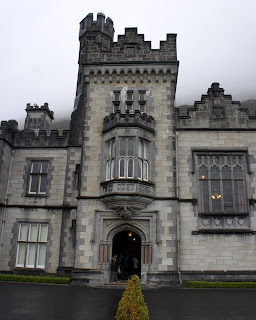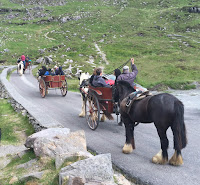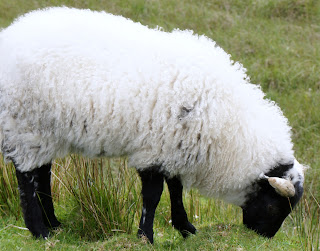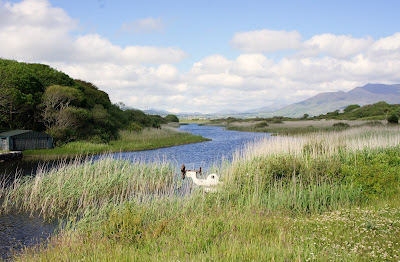By late June, we disembarked at Southampton and took the Flybe across Wales and the Irish Sea to Dublin.
Cead Mile Failte
(A hundred thousand welcomes)Cead Mile Failte
"But I, being poor, have only my dreams; I have spread my dreams under your feet; tread softly because you tread on my dreams."
- William Butler Yeates
After a relaxing overnight stop at Mullingar and good weather in store for at least another day, we had our sights turned towards Kylemore Abbey in Connemara.
A lunchstop on the way at Galway city - the 'most irish' of the nation's cities and a 'city of festivals'. We sampled the street scene along Quay Street and Latin Quarter. Grabbed a fish'nchip at McDonagh's ( looked like z place from the crowds lining up) and headed toward our destination for 3 nights - Lodge at Ashford Castle.
Galway buskers are varied and innovative ..all along Shop Street leading towards the Latin Quarters. I was hoping to witness the performance of the Game of Thrones troupe - a 6 person medley of "The Harp The Accordion and The Ugly" see the youtube post Aug 2014, but they weren't around.

The Claddagh Ring shop insignia atop to the left of the street was interesting to peruse. The Claddagh is a distinctive design featuring two hands clasping a heart, usually surmounted by a crown. Three elements reside in the design. The heart symbolize the qualities of love, friendship (hands) and loyalty (crown). Several myths surround the claddagh ring origin. One very romantic legend tells of a man named Richard Joyce, a native of Galway. He left town to work in the West Indies, intending to marry his love when he returned. However, his ship was captured and he was sold as a slave to a Moorish goldsmith. In Algiers, with his new master, he was trained in his craft. When William III became King, he demanded the Moors release all British prisoners. As a result, Richard Joyce was set free. The goldsmith had such a great amount of respect for Joyce that he offered Joyce his daughter and half of his wealth to stay, but he denied his offer and returned home to marry his love who awaited his return . During his time with the Moors he forged a ring as a symbol of his love for her. Upon his return he presented her with the ring & they were married.
Driving thru Connemara encountering sheeps along the roadside.. a reoccurring phenomenon around these parts
...almost to Kylemore ...
"Green is the prime color of the world, and that from which its loveliness arises" - Pedro Calderon de la Barca
After we've done capturing the exterior view of this dramatic gothic castle, we decided to delay purchasing tickets for the tour for another day...and opted to keep on driving thru the Connemara Loop (map below)
..the human Inukshuk ..life imitating art ..haha
We drove past several oyster, mollusce & shellfish hatcheries along this western coastline on Connemara
Settling in our destination for three nights - The Lodge at Ashford Castle. This well maintained inn used to be the home of the General Manager of Ashford Castle. Since 2008, after purchase for 50 million Euros, Beatrice and Stanley Tollman ( of the Red Carnation Group ) has integrated it with their acquisition and refurbishment of Ashford Castle Estate.
 The accommodation is built around an attractive landscaped courtyard with a beautiful direct view from our window of Lough Corrib as we discovered after plunking down our travel gear.
The accommodation is built around an attractive landscaped courtyard with a beautiful direct view from our window of Lough Corrib as we discovered after plunking down our travel gear.
 Another morning and how the mists does change the look of Kylemore ("An Choill Mhor" meaning "The Big Wood") This time we are entering to tour the interior and woodland trails. Only a small section of the Abbey was open for viewing ...about 6 rooms.
Another morning and how the mists does change the look of Kylemore ("An Choill Mhor" meaning "The Big Wood") This time we are entering to tour the interior and woodland trails. Only a small section of the Abbey was open for viewing ...about 6 rooms.

Picture of Margaret Vaughan, the wife of Mitchell Henry, originally a surgeon. The couple were honeymooning here in 1849 and were totally enchanted by the rugged beauty of Connemara. Some years later, after Mitchell received a substantial inheritance from his father's textile firm, he returned, bought 15,000 acres and created Kylemore Castle as a gift for his wife.
Margaret tragically died of dysentery at the age of 45 while on holiday in Cairo Egypt (Nov 1874) with her husband, family and friends. The couple had nine children, the youngest was then just two years old.


Their daughter Geraldine, tragically drowned in the Dawros river. After WWI, the castle & estate was put up for sale - Sept 1903, the Duke and Duchess of Manchester purchased Kylemore for only 63,000 pounds. Florence Henry, their second youngest child was an exceptional salmon angler & did spend all of her life in Connemara. The Duke, being a cad and gambler, lost the entire estate on a card game to Fawke, who later sold it to Nuns of the Order of St. Benedict ( refugees from Ypres, Flanders) for 45,000 pounds & a girls boarding school was established.
Mitchell Henry never remarried after Margaret's early death. Lovingly, he had her body embalmed and brought back from Cairo to Kylemore and built the mausoleum and a 'cathedral-in-miniature' in her memory. His ashes are laid to rest next to Margaret in the mausoleum.
Famous Fushsia design of the Kylemore Abbey pottery was gifted to Michelle Obama in 2013. Below the Gothic cathedral erected by Mitchell in honor of Margaret Henry

Victorian walled garden
Across from the Burren - a shear cliff drop - well, it is the Wild Atlantic Way !!



A misty day calls for a visit to the nearby Doolin Cave 'Pol an Ionain' or 'Ivy Cliff Cave'. It was founded in 1952 by two cavers (Dickenson & Varley ) after several years of arduous digging and crawling. We were treated to a replay of their amazement by our guide who insisted to cut the cells so we'd be in total and utter pitch blackness right at the chamber of the giant stalactite before the flood lights flicked on. The Doolin cave's limestone free-hanging stalactite is the longest (23 feet ) of the Northern Hemisphere.
Checking out of Inn - last few pics for memories sake of the spectacular Lisloughrey Quay of Lough Corrib. This area is where 'The Quiet Man" film was made and the village of Cong still commemorates it. Sir William Wilde, (father of Oscar) also settled here and the "Wilde" restaurant at the Lodge is a tribute to the extraordinary surgeon, archaeologist and writer.


We elected to take most of our meals during our stay at this charming traditional thatched cottage, Cullen's which featured some special recipes from South African native, Beatrice Tollman. We especially loved, loved, loved (yes, we went back 3x) the ceviches trio ...best !!

After goodbyes to Ashford Castle and Village of Cong ...we are on the road again...
The Burren is an immense area covering 160 square km. There are no bogs and virtually no pastures which are generally ubiquitous in the counties of Ireland. Instead, track and tracks of limestone covering called "clints" marked by vertical fissures called "grikes". Looked completely inhabitable, but there are evidence of stone age settlements and tombs all around. Massive dolmens, wedge tombs and stone forts 'cahers' remenants are strewn in the landscape

Soaring 702 feet above the sea, the vast array of panel like green covered cliffs stretch for 8 kilometers (5 miles) along the Atlantic coast of County Clare. It was fantastic just to walk the well worn trails from the one tip to the opposite. At certain points towards Hags Head, it got very very windy.. we were about 1 km shy of reaching the end before we doubled back to do the trail past O'Brien's Tower
Selfie stick comes in handy here to video the crashing waves without veering off the cliffs
View of the Branaunmore sea stack

It was supper time when we left the cliffs and drove to Bunratty Castle Hotel & Folk Park in Shannon to take in our next entirely Eire venue - a Medieval Castle Banquet. Like the Blarney Castle stop, this was of course entirely obligatory for any tourist new to these parts & we dutifully obliged and did have a roaring good time.

Our dinner merriment was enhanced by an american couple met along the stroll of the Folk Park...lots of red wine and eating with our hands....not to mention goblets of Mead aka "honey wine" or "nectar of the gods". Possibly the oldest alcoholic beverage known to man - made from fermented fruit, honey, water and beer yeast. It was a good thing by evening's end we can just walk up the hilly road to our hotel ..no driving required ..lol
Brunch at the original Durty Nelly's, the quintessential Irish pub, adjacent to Bunratty Castle prior to the drive onwards to Killarney National Park - our final destination in Ireland.
Soaking in the expansive view pre-dinner. The red deers roam all around the grounds here & in particular right outside our room around the shallow inlet pond area ..they come to feed early morning and evening.

Torc Waterfall - easily accessible and close to the Lake Hotel
Visiting the grounds of Muckross House - magnificent Victorian mansion with on site recreation of 70 acres domestic rural farms amidst the spectacular scenery of Killarney National Park
Muckross Abbey ruin has no roof. It was rumoured that this is the Abbey and its adjoining graveyard that inspired Dublin born writer Bram Stoker. Historical records tells of a religious hermit named John Drake living in this abandoned friary for 11 yrs during the mid 1700s. Drake famously slept in a coffin... at the same site, ancient legend tells of the "Brown Man" who was seen by his wife feasting on a corpse within one of the graves. It is thought these spooky stories may have fueled the Dracula novel, written by Stoker upon his visit here late 19th century.
On our second day at the Lake Hotel, we set off for the compulsory Ring of Kerry drive. By now, Tom was thoroughly enjoying driving the quaint narrow country roads that meanders through the terrain


Statute of Daniel O'Connell "The Liberator" or "The Emancipator" born at County Kerry in Cahersiveen.
Pic to left provides a glimpse inside Ireland's ghost farms occurring over various periods of its history. The largest of such abandonment and exodus was the great potato famine between 1845 and 1852
"THE HUMAN SPIRIT NEEDS PLACES WHERE NATURE HAS NOT BEEN REARRANGED BY THE HAND OF MAN"

Towards noon during the Ring of Kerry drive, the clouds started to waft over the hills... we took a timely lunch by beautiful O'Carrolls Cove - wonderfully fresh shellfish to accompany the magnificent views of the beach as the clouds gradually dissipated
When the sun resurfaced, we doubled back from O'Carrolls cove back up N70 to the hilltop of Caherdaniel that overlook the harbors...the advantage of having our own car to navigate independently
Here we are wandering the grassy moorlands in differing directions separated by a sprinkling of sheeps ...
...not quite the English moors of Wuthering Heights but, walking atop it..can't help imaging this must be a fairly close version to it ..well, it is wide & wild, airy & open... & not but a hour ago the very spot we stood would have seemed bleak and full of 'silvery vapour'...lol
...hark! the figure over yonder ..could that be my "Heathcliff"?

The Ladies View at the Ring of Kerry towards dusk

Back to the Lake Hotel and this night off the balcony two white swans took to dine in the usual spot of the red deers until they re-emerged again
Last day to enjoy the vista and soak our up some bubbles and rays
..we did a morning walkabout the stretch of grounds around the Lake Hotel ...when a family of swan floated past us ... enjoying a nice family outing obviously


 After checking out and before the drive back to Dublin for our flight home, we took to our last bit of excursion in the area - Gap of Dunloe, but to save time, instead of hiking it we drove through it - lots of jaunty horse carriages along the way...
After checking out and before the drive back to Dublin for our flight home, we took to our last bit of excursion in the area - Gap of Dunloe, but to save time, instead of hiking it we drove through it - lots of jaunty horse carriages along the way...

The Wishing Bridge halfway up the Gap of Dunloe - narrow mountain pass winding between Macgillycuddy's Reeks and the Purple Mtn (named thus for the purple shale that covers the range). We went as far as Lord Brandon's cottage before heading east to Dublin.
'slan abhaile'




























































































































